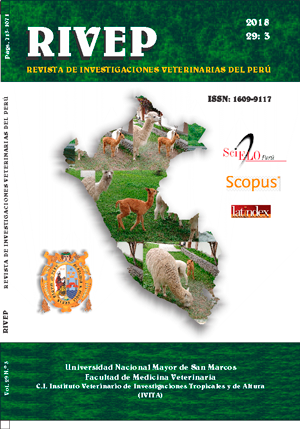Accidents due to dog bites and knowledge of urban rabies in residents of Madre de Dios and Puno, Peru, 2014
DOI:
https://doi.org/10.15381/rivep.v29i3.14837Keywords:
bite, zoonoses, rabies virus, public healthAbstract
The aim of this study was to quantify dog bite accidents and the level of knowledge about urban rabies among residents in Madre de Dios and Puno, Peru. The target population was the student’s homes from public schools, to whom a survey was delivered through their school control book. Information about demography, dog bite accidents reports and knowledge about the rabies was collected. The data was summarized in frequency tables and the association between a dog bite and all the classification variables was determined by chi-square. In total, 2005 valid surveys were collected from Madre de Dios and 883 from Puno. Results showed that 69.5% of the surveyed homes had dogs in Madre de Dios and 57.0% in Puno (p<0.001); 31.8% from the surveyed homes reported that at least one family member suffered a dog bite accident in Madre de Dios and 24.1% in Puno. The dog bite accident was associated with gender (p=0.0007) and age (p<0.0001) of the patients. The majority said that the aggressor dog was known and of a medium or large size. In both regions, the most common dog bite characteristics were unexpected, occurred in a public place, had a unique injury located in the leg or foot, and were treated at home. More than 80% referred that had heard or read about the rabies, and that television was the main information media. Also, only 51.7% knew about the «preventive triad» in Madre de Dios and 56.5% in Puno (p=0.0070). Thus, education programs are required to raise awareness about the importance of rabies in endemic areas.Downloads
Downloads
Published
Issue
Section
License
Copyright (c) 2018 Micaela Talavera T., Blanca Gamboa L., Jeannette Gonzales M., Cecilia Huanambal S., Daphne León C., Néstor Falcón P.

This work is licensed under a Creative Commons Attribution-NonCommercial-ShareAlike 4.0 International License.
AUTHORS RETAIN THEIR RIGHTS:
a. Authors retain their trade mark rights and patent, and also on any process or procedure described in the article.
b. Authors retain their right to share, copy, distribute, perform and publicly communicate their article (eg, to place their article in an institutional repository or publish it in a book), with an acknowledgment of its initial publication in the Revista de Investigaciones Veterinarias del Perú (RIVEP).
c. Authors retain theirs right to make a subsequent publication of their work, to use the article or any part thereof (eg a compilation of his papers, lecture notes, thesis, or a book), always indicating the source of publication (the originator of the work, journal, volume, number and date).



